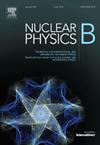The impact of early massive galaxy formation on the cosmic microwave background
IF 2.5
3区 物理与天体物理
Q2 PHYSICS, PARTICLES & FIELDS
引用次数: 0
Abstract
The Cosmic Microwave Background (CMB) anisotropies, corrected for foreground effects, form the foundation of cosmology and support the Big Bang model. A previously overlooked foreground component is the formation of massive early-type galaxies (ETGs), which can no longer be ignored, particularly in light of JWST's detection of massive, evolved systems at extreme redshifts (). The rapid formation of massive ETGs has been advocated in galaxy evolution studies for decades, and recent evidence has compelled even proponents of hierarchical mass assembly to acknowledge the fact that massive ETGs evolve quickly. Constraints from chemical evolution are particularly stringent. Without both intense star formation and a top-heavy galaxy-wide initial mass function of stars (IMF), it is difficult to reconcile stellar population synthesis models with the high metallicity and abundance patterns of α-elements. We infer from previous studies that the progenitor cloud of each massive ETG must have had a radius of ≈400 kpc. Comparing this value to the average present-day separation of massive ETGs, their formation may have occurred around . We consider this epoch of formation in a flat-ΛCDM cosmological context, incorporating the known and necessary properties of massive ETGs – properties encapsulated independently by the integrated galaxy-wide IMF (IGIMF) theory. The massive ETG evolution presented in this work is consistent with recent advancements in stellar and galaxy evolution, and is derived entirely without priors or constraints from the CMB. Yet, it emerges as a non-negligible source of CMB foreground contamination. Even in our most conservative estimates, massive ETGs account for 1.4% up to the full present-day CMB energy density.
早期大质量星系形成对宇宙微波背景辐射的影响
经过前景效应校正的宇宙微波背景(CMB)各向异性构成了宇宙学的基础,并支持了大爆炸模型。一个以前被忽视的前景因素是大质量早期星系(etg)的形成,这一点不能再被忽视了,特别是考虑到JWST在极端红移(z>13)处探测到大质量的演化系统。在星系演化研究中,大质量etg的快速形成已经被提倡了几十年,最近的证据甚至迫使分层质量聚集的支持者承认大质量etg进化得很快的事实。来自化学进化的限制尤其严格。如果没有强烈的恒星形成和星系范围内的恒星初始质量函数(IMF),很难将恒星族合成模型与α-元素的高金属丰度和丰度模式相协调。我们从以前的研究中推断,每个大质量ETG的前身云的半径必须为≈400kpc。将这一数值与现今大质量ETGs的平均分离值进行比较,它们的形成可能发生在15<;z<;20左右。我们在平坦的-ΛCDM宇宙学背景下考虑这个时代的形成,结合了已知的和必要的大质量ETGs的特性-由全星系综合IMF (IGIMF)理论独立封装的特性。在这项工作中提出的大规模ETG演化与最近恒星和星系演化的进展是一致的,并且完全没有来自CMB的先验或限制。然而,它成为了CMB前景污染的一个不可忽视的来源。即使在我们最保守的估计中,大质量的etg也占到目前CMB能量密度的1.4%。
本文章由计算机程序翻译,如有差异,请以英文原文为准。
求助全文
约1分钟内获得全文
求助全文
来源期刊

Nuclear Physics B
物理-物理:粒子与场物理
CiteScore
5.50
自引率
7.10%
发文量
302
审稿时长
1 months
期刊介绍:
Nuclear Physics B focuses on the domain of high energy physics, quantum field theory, statistical systems, and mathematical physics, and includes four main sections: high energy physics - phenomenology, high energy physics - theory, high energy physics - experiment, and quantum field theory, statistical systems, and mathematical physics. The emphasis is on original research papers (Frontiers Articles or Full Length Articles), but Review Articles are also welcome.
 求助内容:
求助内容: 应助结果提醒方式:
应助结果提醒方式:


